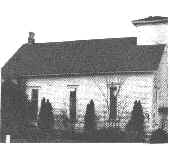On these pages is a brief history of Grace and Zion congregations and the future that we are making together. Both our past and our future are testimonies to what God can do in His children's lives. To God be the glory!
1874- Zion Lutheran Church Established
1927-Pastor Leyrer, Stability and Improvement
1955-Pastor Maas, a Period of Growth
1976 - An Elementary School Begins
2000 -A New Opportunity for Growth
The story of Grace Ev. Lutheran Church had its
be-ginnings with the Bethany German 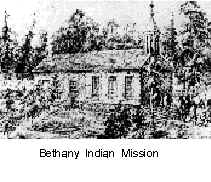 Lutheran Mission established northeast of
St. Louis, Michigan.
Lutheran Mission established northeast of
St. Louis, Michigan.
A small cemetery with a few lonely graves and a small monument is all that is left in remembrance of the Bethany Indian Mission which was founded in 1848 and was supported by the Mission Society of Dresden, Germany. The mission was later run by the Lutheran Church-Missouri Synod.
Pastor Friedrich August Craemer (b.1812, d. 1891)
from the Frankenmuth colony was commissioned to open a mission among the Chip-pewa (or
Ojibway) Indians. Edmund Raimund Baierlein (b. 1819, d. 1901) joined the Frankenmuth
colony June 10, 1847. About a month later, Chief Bemassikeh came to Frankenmuth from a
place called Shimguagonshkom,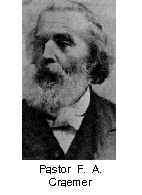 "a place of small pine trees." He
pleaded with Craemer, "Come. Teach
"a place of small pine trees." He
pleaded with Craemer, "Come. Teach 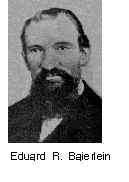 my people the truth." Pastor
Baierlein visited Bemassikeh that fall. Bemassikeh encouraged Baierlein to make his home
near the Pine River and teach his people. In May of the following year, he returned and
established the mission. It was called "Bethany," which is Hebrew for
"house of misery," because of the poverty and poor living conditions of the
Indians. A log house and a chapel were built.
my people the truth." Pastor
Baierlein visited Bemassikeh that fall. Bemassikeh encouraged Baierlein to make his home
near the Pine River and teach his people. In May of the following year, he returned and
established the mission. It was called "Bethany," which is Hebrew for
"house of misery," because of the poverty and poor living conditions of the
Indians. A log house and a chapel were built.
Pastor Ernst Gustav Hermann Miessler (b. 1826, d.
1916), a student, left Leipzig, Germany and arrived in Michigan in October 1851, equipped
with a Bible and a gun. Pastor Miessler, studied the Indian language, preached the gospel,
and taught the Indian child-ren. In 1852 Baierlein and Miessler had a book printed with
the title Spelling and Reading in the Chippewa Language, containing Old and New Testament
stories, some hymns which were translated from German, the Ten Commandments, and Martin
Luther's morning and evening prayers. 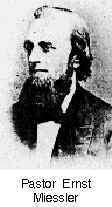
Baierlein succeeded in gathering together a congregation numbering fifty-eight members; they had their own church and school. Not only had the majority of these Bethany Indians accepted the Christian faith, but many of them had permanently settled on the mission land which had been set aside for them. Shortly before his departure in the late spring of 1853, Baierlein wrote: "The might of heathenism is completely broken and only one family still lives according to the old customs, with all the others either standing firm in the Christian faith, or else ready to become Christians."
In 1853, Rev. Baierlein was recalled to work in India. As he and his family boarded the canoe which would remove them from Bethany forever, Ferdinand Sievers, the chairman of the Missouri Synod's mission board, together with the Bethany Indians, sang in German "Allein Gott in der Höh' sei Ehr" ("All Glory be to God on High" CW 263). From that time Missionary Miessler was left alone in the field.
On July 22, 1857, Mrs. Johanna Miessler died in childbirth. She is the only non-Indian buried in the Bethany cemetery. Also buried in the cemetery is Sahrah Miksiwe, "mother of the Chippewas," who died April 12, 1850, at the age of 110 years.
The superstition of the Indians was also a challenge for the missionaries. Missionary Baierlein often served coffee and cake to the Indians whenever an Indian child was baptized. As time went on, it wasn't always possible to serve the refreshments. The first child baptized without coffee and cake died, and after that, no one could make the Indians believe that there was any other reason for the child's death but the lack of coffee and cake at the baptism.
One Indian who served the Bethany Mission well was James Gruett, who was half French and half Indian. He acted as interpreter. His son, Billy Gruett, was a familiar figure at the mission. He carried mail by pony to Mt. Pleasant along the high ground north and west of St. Louis. The winding road is known as Gruett Road today.
Work among the Indians in Gratiot County went well until the summer of 1855 when the U. S. Government summoned all the tribal chiefs to Detroit where they were told that a large reservation was being established in Isabella County. There Indian families were to receive 80 acres each. And while the Gratiot County village also had a program whereby Indians could own their own land, these holdings were much smaller and the government offer in Isabella County drew most of the Indian families away from the Gratiot County location. Miessler and his family went to work among the Indians of Isabella County alone.
The government's relocation of the Indians to the Isabella County Reservation hindered the work of the mission. In time, Lutheran effectiveness among the Indians declined. The Indians, frequently influenced by the immoralities of the white men, especially the unprincipled peddlers of whiskey and purveyors of "religion," concluded that all white men were deceitful and untrustworthy. As a result, the Indians quit coming to church and their children quit coming to school. In 1869 the Lutheran Church-Missouri Synod terminated its work among the Indians of Isabella County. Missionary Miessler's parting words were: "I leave the mission field, that field of labor and anxiety, with a broken heart and with fervent prayer to the God of mer-cy for the true repentance on the part of the Indians on the reservation."
During his stay at the mission, Pastor Miessler also served some of the early settlers in and near St. Louis, conducting divine services in their homes. After the Indian mission was abandoned and Pastor Miessler was called to teach in Saginaw, the work among the Lutheran settlers suffered and lagged for some time, due to the shortage of pastors and missionaries. Pastors were sent here occasionally, perhaps two or three times a year, to care for the spiritual needs of the settlers.
1874- Zion Lutheran Church Established
As more Lutherans moved into this vicinity and the
homes proved to 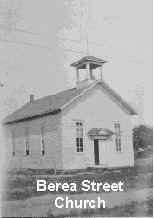 be to small to accommodate all who came to the
services, it was decided to rent the schoolhouse just outside the city, west of the Oak
Grove Cemetery. This soon proved unsatisfactory, and with true Lutheran zeal for a house
of worship of their own, the people planned to build a church.
be to small to accommodate all who came to the
services, it was decided to rent the schoolhouse just outside the city, west of the Oak
Grove Cemetery. This soon proved unsatisfactory, and with true Lutheran zeal for a house
of worship of their own, the people planned to build a church.
During the year 1874, eighteen members organized as a congregation taking the name "Zion Evangelical Lutheran Church." In 1888 a lot was purchased and a church built on Berea Street just north of the city limits, which served the congregation until 1920, when the present church was dedicated.
A bell in the steeple called the worshipers at the start of the service. It was tolled during the Lord's Prayer and for funerals. A wood burning stove with a stove pipe running half the length of the church to a chimney in the rear kept the building reasonably warm during the cold wea-ther. The stove was on the men's side, some pews being left out to accommodate it. As long as the building was used, the men sat on the left side and the women sat on the right. The boys would generally sit with the fathers, but would sometimes join their sisters with their mothers. The women never sat on the men's side.
The little white church has since been converted into a residence, and is still standing at its origi-nal location at 623 Berea Street.
In the year, 1888, Pastor Ziegenhain was called as first resident pastor. He was followed by Pastors O. Moellmer, O. Kuhlow, H. Hahn, and Adolph Sauer. During the vacancies which were frequent and often long, the congregation was served by neighboring pastors.
Pastor Kuhlow sought to extend the preaching of the Gospel into neighboring Alma. Beginning with a nucleus of five families in 1905, Pastor Hahn established St. John's congregation in Alma. Fire destroyed the Alma church on November 7, 1922. Then, after Rev. Bernthal resigned in 1927 to accept a call from St. John's in Clare, the Alma congregation rejoined Zion of St. Louis.
In 1912, the congregation was united with St. John Lutheran Church of Clare, both being served by Pastor Carl W. Waidelich. This arrangement lasted until 1918, when Pastor Waidelich was put in charge of Zion congregation, and the newly- established mission at Alma. For some time, Zion felt the need for a better and more appropriate location for their church, and also for a new building. A piece of property was purchased on Main and Tyrell Streets, and plans for a new church were made.
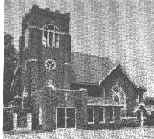 Early in the spring of 1919, ground was broken for the new church. On
May 18, the corner stone was laid. And on August 10, 1920, the beauti-ful new church was
dedicated. The actual cost of the church was $24,000 of which $8,000 were labor, building
materials, and furnishings donated by individuals. The cement was mixed by hand. The
stones for the foundation came from neighboring farms. The bricks came in by rail. Members
gave freely of their time and money to erect the beautiful house of worship which still
stands today.
Early in the spring of 1919, ground was broken for the new church. On
May 18, the corner stone was laid. And on August 10, 1920, the beauti-ful new church was
dedicated. The actual cost of the church was $24,000 of which $8,000 were labor, building
materials, and furnishings donated by individuals. The cement was mixed by hand. The
stones for the foundation came from neighboring farms. The bricks came in by rail. Members
gave freely of their time and money to erect the beautiful house of worship which still
stands today.
Even with the donations, the building of such a church settled a heavy debt upon the congrega-tion. Due to unfortunate circumstances in the congregation, and frequent vacancies for several years, the debt increased rather than decreased.
In the fall of 1920, Pastor Waidelich resigned from Zion, and for several months the congregation was served by Prof. O. Hoenecke of Michigan Lutheran Seminary, Saginaw, Michi-gan. At that time Prof. Hoenecke would come in by train. A member would meet him, keep him over night, and get him back to meet the train after the service on Sunday.
Pastor Leonard C. Bernthal was called and installed on August 14, 1921. In 1925, he moved to Clare and continued to serve until he resigned his pas-torate in February 1927. It was during Pastor Bernthal's tenure that the work of the Sunday School was started, mainly through the efforts of Mr. & Mrs. John Longanbach. When Pastor Bernthal left, Prof. Hoenecke again took over. This time he came from Saginaw by automobile. Zion congregation is deeply indebted to Prof. Hoenecke for his efforts in keeping the doors of the church open so that the Gospel could be preached in the middle of a large area where conservative Lutheranism was lacking.
1927-Pastor Leyrer, Stability and Improvement
Pastor C.G. Leyrer of Lansing, was installed on July 3, 1927. At that time the synod was subsi-dizing the house rent and it was decided to put this into a new parsonage. In 1930, a spacious, new parsonage was built next to the church at the cost of $4,500. Only $900 of this was furnished by the congregation. The remainder was taken by the Synod. Gradually the debt was liquidated. In November 1944, the mortgage of both the church and the parsonage was burned. Zion has been self-supporting ever since.
1955-Pastor Maas, a Period of Growth
Pastor Norman Maas, who had been serving Grace Lutheran Church in Durand and Hope Lutheran Church in Swartz Creek, was installed on May 1, 1955.
During the tenure of Pastor Maas, 236 children and 63 adults were baptized, 206 confirmations, 102 marriages, and 67 burials were performed.
At the close of 1971, Pastor Maas accepted a call to Zion Ev. Lutheran Church of Toledo, Ohio. This left both the pastorate of St. Louis and Alma vacant.
Again Alma called! Sponsored by Zion, and lead by Pastor Maas, on February 1, 1959 branch services were started in Alma. Worship services were held in the Seventh Day Adventist Chapel, located at the corner of Hastings and Gratiot Streets just north of the Alma Middle School. This building was used for services until May, 1966.
Attendance in Alma grew and sixty-nine charter members developed plans to separate from their mother congregation, Zion. On July 26, 1962, they petitioned the Michigan District Mission Board of the Wisconsin Evangelical Lutheran Synod to estab-lish a separate congregation in Alma. At an October meeting the request was approved and on November 10th, Martin Luther's 479th birthday, the members were notified that Grace Evangelical Lutheran Church was officially recognized.
Thus, our congregation shares its birth date with the founder of Lutheranism and the author of that Latin phrase, sola gratia, that gives us our name: Grace.
Zion Lutheran Church was generous in its encour-agement and support of their daughter congregation in Alma. For over 13 years Zion carried the major financial responsibility for the dual-parish; they contributed $1,000 in 1963 to the Grace building fund and gave hymnals for use in worship services.
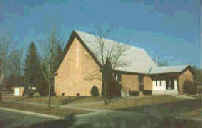 A year later, in 1963, land was purchased
at the corner of West Superior Street and Purdy Drive. Architectural planning, and a
request for financing the construction of a church building through a Church Extension
Fund loan, began soon thereafter. Groundbreaking ceremonies were held at the building site
on February 28, 1965. Church Builders, Inc. of Milwaukee served as architect and general
contrac-tor) they began construction on July 9, 1965. The first service was held in the
new sanctuary on May 29, 1966 and dedication services were held five months later, on
October 23.
A year later, in 1963, land was purchased
at the corner of West Superior Street and Purdy Drive. Architectural planning, and a
request for financing the construction of a church building through a Church Extension
Fund loan, began soon thereafter. Groundbreaking ceremonies were held at the building site
on February 28, 1965. Church Builders, Inc. of Milwaukee served as architect and general
contrac-tor) they began construction on July 9, 1965. The first service was held in the
new sanctuary on May 29, 1966 and dedication services were held five months later, on
October 23.
By August of 1963 communicant membership had grown to 78, numbering 122 baptized souls in 37 families. By 1974, there had been 50% growth; the communicants numbered 128, with 182 baptized members. By the year 2,000 over 750 souls have called Grace home. We have been richly blessed by each and every one of them.
1976 - An Elementary School Begins
The decision to fund and operate a Christian Day School is a difficult and momentous one for any congregation. Grace congregation is no exception. In the early 1970's opening a day school had been proposed several times. Some families enrolled their children at St. John's Lutheran School in Hemlock and endured the long trips each day. Finally, in early 1976 the voter's adopted the recommendations of a school feasibility study committee and made the bold decision to test our commitment to the school concept by establishing a building fund goal for a classroom addition and a deadline to achieve that goal.
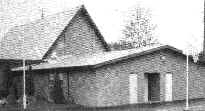 Estimating the
construction costs at $40,000 or more, the goal was to raise $20,000 in cash with-in a
year, over and above the regular church budget. This goal was set because it was
approximately the amount which would be required in the annual budget to fund one teacher
and provide for school ex-penses. One year later the members had given generously and God
had spoken: well over $25,000 was in the school building fund in cash and pledges. The
voters agreed to borrow the balance through a LACE loan and to request synod to assign a
DMLC graduate as our first teacher. Plans for a class-room-office-restroom addition were
developed and construction began in early summer. Miss Charmaine Huff was assigned as the
teacher and Mrs. Marion Roth volunteered to handle kindergarten and serve as an aide.
After necessary authorization was obtained, Grace Lutheran school opened with an
enrollment of 12, at first in the church basement and, soon thereafter, in the newly
opened classroom wing.
Estimating the
construction costs at $40,000 or more, the goal was to raise $20,000 in cash with-in a
year, over and above the regular church budget. This goal was set because it was
approximately the amount which would be required in the annual budget to fund one teacher
and provide for school ex-penses. One year later the members had given generously and God
had spoken: well over $25,000 was in the school building fund in cash and pledges. The
voters agreed to borrow the balance through a LACE loan and to request synod to assign a
DMLC graduate as our first teacher. Plans for a class-room-office-restroom addition were
developed and construction began in early summer. Miss Charmaine Huff was assigned as the
teacher and Mrs. Marion Roth volunteered to handle kindergarten and serve as an aide.
After necessary authorization was obtained, Grace Lutheran school opened with an
enrollment of 12, at first in the church basement and, soon thereafter, in the newly
opened classroom wing.
In 1983, in response to rapid growth in en-rollment a second teacher was called. In an out-pouring of love of the Lord, the members pledged and loaned $15,000 toward a school addition and agreed to borrow an equal amount in a second LACE note. After two months of summer construction, the enlarged classrooms were opened in September 1981. The enrollment follows:
Even though we were saddened by its closing in 1992, nevertheless there was joy in our heart. Joy from the thankfulness that God has richly blessed us through our school. Joy in knowing that for 15 years a congregation which was "too small" to support a school maintained one. Joy in knowing that even in what seems to be an unhappy situation from our perspective, can be used for blessing from God's perspective. And finally there is joy in hoping that someday, God may again present the opportunity for our congregation to again have a Lutheran Elementary School.
God continued to direct his people into many
blessings. The congregation began a new youth group, 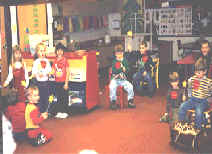 the Explorers, for children in grades 1-8. This group has since split
into two groups, the Explorers for children Kindergarten through 6th grade and the teen
group (7th grade through High school) affectionately known as the J.A.M. session, or
"Juniors Advancing in Ministry."
the Explorers, for children in grades 1-8. This group has since split
into two groups, the Explorers for children Kindergarten through 6th grade and the teen
group (7th grade through High school) affectionately known as the J.A.M. session, or
"Juniors Advancing in Ministry."
In 1994 Grace experimented with its first television commercial aired on cable channels. This commercial advertised our children's Christmas Eve service. Since then we have added a yearly ad for the Preschool and Easter. Consideration is now underway to record our weekly services and air them as well to serve both our shut-in members and the community.
In 1996 The Holy Spirit lead the members of the congregation to open a preschool for four year old children. The voters called Rachel Biedenbender of Mt. Pleasant, to be our preschool teacher. Sue Eich was called as the aide and secretary for the preschool. Under their guidance and with the Lord's blessing enrollment continues to grow. After repeated requests from parents with younger children the preschool added a three old program in 1999. We are now looking ahead to possibly adding a Kindergarten level as well.
2000 -A New Opportunity for Growth
In April of 2000, Zion's current pastor, Paul Stratman, was moved by the Holy Spirit to accept a call to pastor a church in Minnesota. The voters of Zion approved approaching Grace's pastor, John Eich to serve as vacancy pastor. Yet there was a unique twist to the request. Zion's church council wanted to meet with the council of Grace and discuss the possibility of merging the two congregation's ministries. This was brought about by the pastoral shortage within the WELS and the close proximity of Grace and Zion to each other. One year was granted for this discussion.
After six months of discussion, research and prayer, after reviewing the possibilities of remaining separate congreations, or becoming a dual congregation, the Holy Spirit lead the voters of both churches to approve merging into a new congregation with a new facility. Work is currently being done to carry out this decision. The name for our new congregation is Good Shepherd Evangelical Lutheran Church.
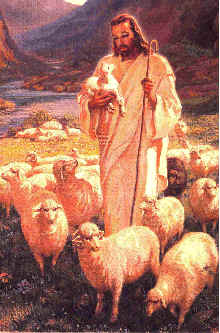 I am Jesus'
little lamb. Little children and even grandmas and grandpas love the Bible's imagery when
it calls us sheep and lambs. Our mind almost instantly flashes a mental picture of a
beautiful sunny day, with a flock of white, fluffy sheep grazing contentedly. A shepherd
sits on the hill watching his flock, gently caressing a baby lamb in his arms.
I am Jesus'
little lamb. Little children and even grandmas and grandpas love the Bible's imagery when
it calls us sheep and lambs. Our mind almost instantly flashes a mental picture of a
beautiful sunny day, with a flock of white, fluffy sheep grazing contentedly. A shepherd
sits on the hill watching his flock, gently caressing a baby lamb in his arms.
It's a beautiful name with beautiful meaning for us. The name Good Shepherd brings to mind the 23rd Psalm and John 10 which describe the work and the blessings which are ours through Jesus, our Good Shepherd.
Our new name should remind us that we, like sheep, keep wandering away from God. We get ourselves into all kinds of trouble. It starts with a little temptation and ends in great danger. And we don't even see it coming.
But our Good Shepherd seeks us out to restore us in the paths of righteousness, and to refresh us by the still waters and green pastures. Isn't that what a Lutheran church is to be? Our church will be a place where sinners can be restored and refreshed through the Word of God and the Sacraments; and through our fellowship and love for each other.
There is a peacefulness and security which we have knowing that Jesus is our Good Shepherd. Despite the changes that are occuring in our churches, and despite not knowing what the future holds, we can be confident and safe with Jesus as our Good Shepherd. Our Good Shepherd goes before us and prepares our table. Jesus holds our future in his hands, and so we know we will be blessed and thrive as a Lutheran congregation. His rod and His staff comfort us as He keeps danger away and keeps us close to Him. Our new church will be a place of close. personal communion and safety with our Good Shepherd.
Jesus said, "I know my sheep and my sheep know me." Now we will be known as the church of the Good Shepherd.
To God Alone be the Glory!
As Grace and Zion Lutheran churches advance into the 21st century, we go forward in Christ keeping the 3 R's of our existence in mind. We remember the past blessings and guidance God has given which have brought us this far; we rejoice in worship as we praise and thank God for his blessings; and we respond in service as we meet the new opportunities God continues to present to his church.
